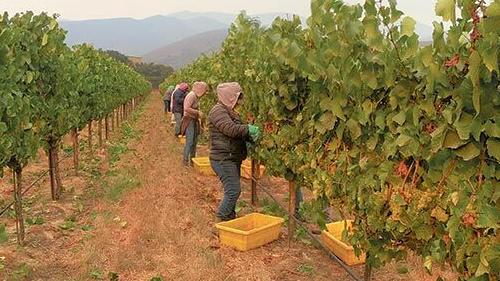
EARLY ON THE MORNING OF AUG. 18, harvest crews were picking Chardonnay grapes for sparkling wine that Hahn Family Wines will make. They worked under an eerie gray sky, not from the usual fog layer that might protect them from the sun, but from the thick smoke of the nearby River Fire, burning on Mt. Toro.
Paul Clifton, vice president of operations and director of winemaking at Hahn, is no stranger to wildfire. In 2016, as the Soberanes Fire raged, burning more than 100,000 acres over nearly three months through grape harvest season, the smoke lingered. But the grapes – and the eventual flavor of the wine they produce – were unaffected.
That makes him hopeful that the River Fire won’t damage this year’s crop. “In 2016, I saw days like this every day for weeks and weeks, and we had no problem,” Clifton says. “We were really worried at that point, and none of the fruit was affected.”
When he did experience a problem was in 2008, when a grower in Arroyo Seco harvested grapes adjacent to a fire. The idea of smoke taint damaging wine grapes was then just an emerging idea, with winemakers in Australia leading the research. After Hahn harvested the grapes and made the wine, Clifton tasted it, and it was bad.
“It’s like a retro-nasal aromatic in your mouth, and it tastes like ashtray,” he says. “I’ve only tasted that a few times in my career.”
The River Fire is burning to the north of Monterey County’s River Road vineyards and wineries, and the wind so far has been largely blowing smoke to the southeast. But winemakers and grape growers are watching closely, and relying on chemistry to know exactly how it’s affecting their grapes.
Before harvest begins, growers collect grape samples to test for sugars anyway – grapes for sparkling are ready to harvest, with a lower sugar level and higher acidity – with grapes still to follow at the end of August. But in addition to testing for sugar, wineries like Hahn are also testing for the compounds that are elevated from smoke and would show evidence of smoke taint. That meant on Aug. 17, the day after the River Fire started, they picked some 250 berries from roughly 40 vines, sealed them in glass jars or Ziplocs, chilled them and delivered them to ETS Laboratories in Paso Robles. There, they’ll blend the fruit, put it into vials, and run it through gas chromatography to produce a spectrum revealing their molecular makeup.
They’re looking for two compounds, guaiacol and 4-methyl guaiacol, which will give a baseline; then, if those compounds increase beyond a certain threshold, vineyard managers will know to be wary. (The proof is in the chemistry, and in the taste – even if those compounds creep up, Hahn would do small-batch fermentation in buckets to sample the wine itself.)
More than anything, the fire has people in the wine industry on edge, says Kim Stemler, executive director of the Monterey County Vintners & Growers Association. Come harvest season, they’re all bracing for a relatively sleepless time anyway, monitoring weather conditions and testing grapes for the chemical profile that shows they’re ready to harvest; hot weather like we’ve experienced recently can elevate the sugar profiles, moving the ideal picking date up.
“Everybody is getting into the time when they don’t sleep, and they don’t eat that much,” Stemler says. “Maybe that started a little early because of the fire.”
At Hahn, they make an annual T-shirt to distribute to their harvest crew. Last year, it was a simple grape crush image. Clifton says this year, faced with the pandemic and required social distancing measures, followed by a fire, they’re thinking of a different harvest T-shirt theme: “Now I’m thinking it should just be a big middle finger.”
The Link LonkAugust 20, 2020 at 02:00PM
https://ift.tt/34h5zD9
Grape harvest season begins on River Road, even as smoke threatens wine. - Monterey County Weekly
https://ift.tt/3eO3jWb
Grape

No comments:
Post a Comment